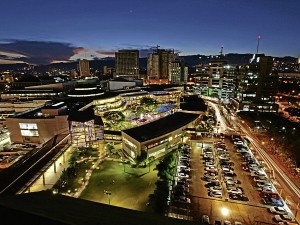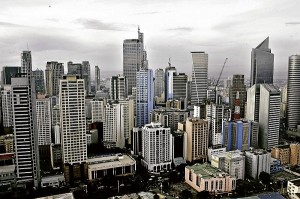Property experts name top Philippine cities for yuppies

IN METRO Cebu, the investments and opportunities are pouring in due to its strategic location. FILE PHOTO
Last March 31, before the country went into the Holy Week break, Inquirer Property revealed the 11 top criteria for ideal cities to settle into, according to property analysts.
In that story, Enrique Soriano, Ateneo program director for real estate and senior adviser for Wong+Bernstein Business Advisory, David Leechiu, country head of Jones Lang LaSalle Leechiu, Lui Matti, executive director for asset services, CB Richard Ellis Philippines, and Claro dG Cordero Jr., Jones Lang LaSalle Leechiu’s head of research, consulting and valuation, explained that for the mid-level, upwardly mobile yuppies, the ideal cities should offer the quality of life that enhances the following: uncongested spaces, with the right balance of greens/fresh air and cosmopolitan lifestyle); job opportunities; peace and order; proximity to business contacts, malls, cultural places, theaters, meetings for intellectual discourse, and hospitals.
Cordero clarified, however, that, “Ideally, a formal survey/study should be conducted and a well-defined metric should be in place to rank cities in the Philippines; however, what we mentioned here are only indications and are based from the information that are readily available to us at this time.”
So, given these conditions, what are these most liveable cities for the young generation? Here they are, in no particular order:
Cebu (Metro Cebu)
Article continues after this advertisementThe “Queen City of the South” is Soriano and Matti’s top pick, and Cordero’s fifth. They explain that in Metro Cebu, the investments and opportunities are pouring in due to its strategic location. Cordero said that “similar to Davao, the masterplanning should be significantly improved to ensure sustainable and efficient growth of various systems (infrastructure, crime prevention and ability to service the basic needs in the long run).”
Article continues after this advertisementMatti picked Cebu as a serious option (for young professionals like him to settle into). He described Cebu as “cosmopolitan enough to be interesting for someone from a big city, with a booming local economy, and thus, plenty of job options. The cost of living seems to be lower than in Manila, as well. Traffic is an issue, but still better than in Metro Manila.”
He added that Cebu is also a good jumping point to other places of interest like Iloilo, Bohol and Cagayan de Oro. “The international airport is also a plus. They also have good schools and nearby beaches.”
Taguig (particularly Bonifacio Global City)
Taguig, and in particular BGC, is Soriano’s third pick, while BGC is Leechiu’s top choice. Leechiu said BGC is a prime example of an ideal district. He said that in BGC, “you have everything one needs, full of symmetry and balance of developments, and culture; backed up by strong infrastructure and strong policies and strong owners.” BGC, he said, has the following qualities: the city chic, new buildings, sporty lifestyle and an international community.
BGC is Cordero’s second pick due to its “world-class design for infrastructure (controlled development density, underground facilities, transportation and sustainable designs and practices (i.e., recycling of non-potable water, presence of advanced sewage systems).”
Makati
The city that is home to the financial heart and soul of the Philippines is Cordero’s top pick, mainly for being the “traditional business district where most businesses thrive and mature property developments are located.”

MAKATI is considered the traditional business district where ‘most businesses thrive and mature property developments are located.’ FILE PHOTO
Makati is Soriano’s seventh, and Leechiu’s fourth. “Yes, it’s severely congested today, but gradually that should improve as Ayala Land puts more infrastructure in place. My hope is that Makati and BGC is integrated as one district. This will require a lot of effort and resources, but this is the inevitable direction,” Leechiu said.
“Makati’s congestion is being solved with more infrastructure projects in the pipeline, such as walkways, bus transits and more parks opening. Legaspi Village has been left behind but now there is an effort for old buildings to give way to new ones. Macea-Ayala needs to invest more in making Legaspi Village more pedestrian-friendly and open up more areas for parks and trees, such as replicating what they did in Greenbelt-Glorietta to the rest of Legaspi Village and Makati,” Leechiu added.
Muntinlupa (particularly Alabang Business District)
Muntinlupa is Soriano’s second most ideal location, and Leechiu’s third, mainly because of the Alabang Business District. Leechiu said: “Combining the Madrigal Business Park, Ayala Alabang, and Filinvest Corporate City, this really was the first live-work-play concept put to action.” He added that the Alabang district has been around for about 25 years and truly brings people from all walks of life and integrates them successfully.
Leechiu added that the plus points for Alabang are: Property values are the cheapest, and present the best value for money. It also has the highest ratio of open spaces to developed land with its various parks and convention areas. The air is cleaner and the location has the most greenery (plants and trees).
Clark Special Economic Zone
Though not a city, CSEZ, according to Soriano, deserves special mention and thus takes his sixth spot. Matti and Cordero also names Clark their third. The latter particularly specified the Clark-Subic corridor mainly for “the availability of developable land, as well as superior level of infrastructure links (air, land and water transport).”
Santa Rosa, Laguna
Not just a place for “enchantment,” Santa Rosa is making a name for itself as the Lion City of South Luzon, and has become top of mind among investors, as it plays host to the thriving Laguna Technopark and other satellite cities and posh subdivisions. Santa Rosa is Soriano’s fourth most ideal city, and Matti’s sixth.
Tagaytay City
Twenty minutes upland of Santa Rosa is the popular summer destination of Tagaytay, where Soriano said he would someday want to relocate to. “Tagaytay represents all the key quality of life elements, from lifestyle to wellness and access to arts and culture, medical services, and world-class education in Sta. Rosa, its next-door city.”
Davao City
Davao City is Soriano’s fifth, Matti’s second, and Cordero’s fourth. Their reason: “The relatively secure environment has been attracting investors to the city (although major infrastructure programs should be implemented in the soonest possible time to address concerns such as traffic and excessive flooding).”
Pasay (particularly Bay City)
Bay City (the centerpiece of which is the SM Mall of Asia) is Leechiu’s second pick. The SM MOA–Bay City, he said, is the “ultimate success story of a district that started with nothing but a dream, and now is the next fastest growing district in the Philippines; having not just office and retail and residential, but massive events venues to showcase the best the country has to offer.”
Other cities mentioned by the analysts were Baguio (Soriano’s sixth, Matti’s fourth) and Iloilo (Soriano’s seventh, and Matti’s fifth).
Much as these aforementioned cities are head and shoulders above their counterparts, Cordero notes “it is still very hard to assess where to settle for good, since these areas still have a wide room for improvement, and each offers unique features that would appeal to my diverse needs.”
So, what is your ideal, most livable city?
Next: Inquirer Property readers name their favorites
E-mail the author at [email protected].